|
|
|
The Kicking Guy
by Cliff Martin
I needed a thrashing body that's suspended overhead for my haunt.
Not hanged, but a "captured" person, hanging from the
back by a rope under its arms and over its chest. (no, I haven't
got the rope on yet in the photo!)
I built it out of PVC pipe (of course) and used a small air cylinder
to make it thrash as if trying to get out of its bonds. It works
quite well. the finished body only weighs 5 pounds (mostly clothes)
and is quite sturdy.
I've just finished the body, so the description that follows
may lack some needed detail. But, feel free to experiment! There
is no ONE right way to build anything for Halloween.
And if it works, but it ain't perfect, say what we do:
"Course it ain't perfect, its a haunted house!"
|
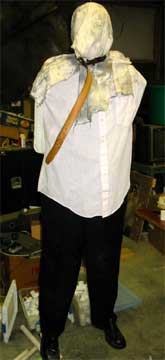 |
| The body is constructed from different
sizes of PVC pipe. The pipe thickness is "Schedule 40"
or thicker. Just pick the 'thick pipe' at the store.
PVC comes in 10' lengths, so you will need one 10' piece of 1",
3/4", and 1/2" pipe. And you'll have some left over.
You'll need these PVC fittings:
|
1" fittings
|
1 - cross tee,
1 - regular tee,
1 - 1"x 1/2" reducing coupling |
|
3/4" fittings
|
2 - ells,
2 tees |
|
1/2" fittings
|
1 - ell,
1 - 45 |
Also you'll need:
| Small bag of 8" zip ties |
| Small bag of 4" zip ties |
| One foam 'pool play tube' |
| One 18" x 36" piece
of landscape cloth |
| Four U-bolts, 1.5" wide x 2.5" long |
| Two 6" pieces of 1/8"
x 1" angle steel |
| One 6" piece of 1/8"
x 2" plate steel |
| One 34" piece of 1/4" steel rod |
| One double acting air cylinder,
1/2" bore, 2" stroke |
| One four way solenoid |
| Fittings and pipe for air cylinder
and solenoid |
| Repeating timer, on/off switch,
sensor |
| Styrofoam wig head, latex hands |
| Shirt, pants, shoes, belt (get at yard sales!) |
| Pieces of plastic packing bubble sheets, or
foam carpet padding (to give shape to the legs) |
| Tape, PVC glue (or screws), PVC pipe cutter
(hightly recommended), misc. tools |
Construction of the body is straight forward, cutting the pipe
and assembling it with the fittings. I'd recommend cutting all
the pieces and test fitting them together first to be sure everything
goes together BEFORE you glue it together. Once glued, it does
not come apart!
Hint: When building a new prop, I test fit everything. Then when
it all looks right, I drill small holes into the fittings and
through the pipe, then insert a screw to hold it together. This
gives lots of flexibility just in case something needs to be taken
apart again. I have several props that only have screws holding
them together and have worked well for several years. |
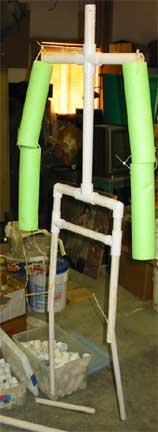
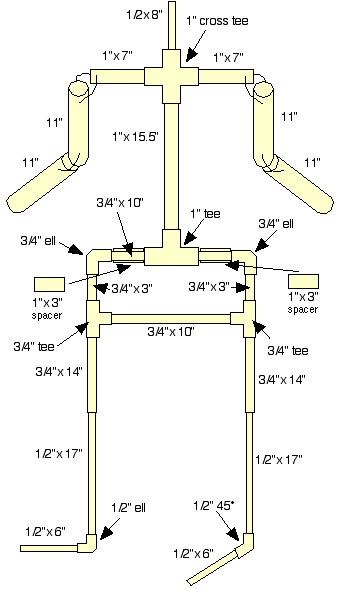
|
| The hip joint is built by using a
single piece of 3/4" pipe that goes through the 1" tee
fitting and connects to each leg. Add a 1"x 3" spacer,
one on either side of the tee. to keep the legs from flopping
from side to side.
The 3/4" pieces are connected firmly together, and pivot
inside the 1" spacers. |
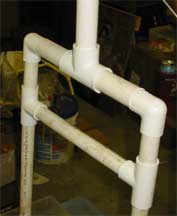
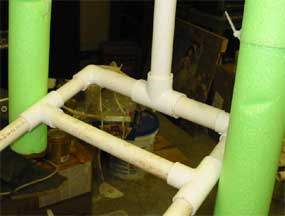
|
| The arms are made from a foam pool
play tube. Cut four 11" pieces, then drill or poke a hole
about 1"- 2" from each end.
Drill a hole in the 1" PVC, and run a zip tie through the
PVC, then through the pool tube. Leave lots of slack, this lets
the arms move.
Then connect the elbows together by drilling/poking a hole 1"-
2" from the ends, then inserting a zip tie to hold them together.
Again, leave lots of slack. |
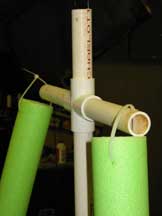 |
| The knee joints need to operate similar
to real knees, they can't just flop about - it looks too corny...
tried it... didn't work! So there has to be a special joint that
works like a real knee. Here's the solution I came up with...
Cut two 14" pieces of 3/4" PVC (upper legs), then cut
a notch in the pipe about 2" long (see photos).
Cut two 17" pieces of 1/2" PVC (lower legs). Drill holes
as shown in the photos, then using a zip tie, attach the upper
and lower leg as shown.
This attachment lets the lower leg move freely backward, but
keeps it from swinging forward.
If you haven't already done it, attach the upper leg to the pivot
joint at the hip.
Cut two 6" pieces of 1/2" PVC and attach to the lower
leg using an ell on one leg and a 45 on the other to act as feet.
|
 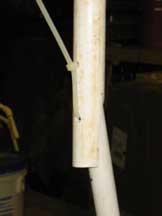
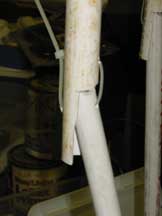
|
| You'll need to make up the brackets
for the air cylinder. There are really lots of options to attach
the air cylinder, but this is the way I did it. Please feel free
to try another way if you think it will be easier.
I welded the pieces shown in the drawings, but a welding shop
can fabricate these brackets quickly and inexpensively - and their
welding will look much better than mine!
The clevis brackets were purchased from my local hydraulic supply
store. I walked in with my air cylinder and asked for parts that
fit the cylinder. I have no idea what size they are. (Welding
effectively erases any marks on the part. )
If you purchase your cylinder, don't forget to order the clevis
parts... it saves lots of time! |
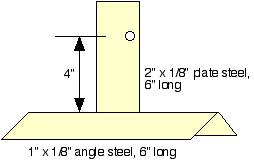  |
| Here's photos of the air cylinder
assembly. The angle steel pieces are attached to the PVC with
U-bolts. No drilling needed.
Depending on the size of the cylinder you have handy, the upper
bracket can slide up and down several inches to accommodate the
cylinder.
I had a small surplus air cylinder that I bought from C &
H, but you can use whatever fits! (that's what I do!)
Adjust the brackets and move the legs up and down to test the
movement of the cylinder. Once you're satisfied with the movement,
tighten down the brackets.
The idea is to make the hips jump up a few inches, then jump
back quickly. This will make the entire body flail about realistically
(and disturbingly!)
The lower legs will move independently from each other, and the
suspended body will rock about in a most unnerving manner....
You can go ahead and connect up the air cylinder to the solenoid
and test the action to be sure the frame works the way its intended.
Be careful, the frame itself is very light, so even a small motion
is very, very fast! |
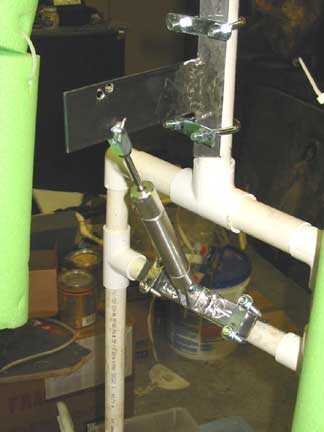
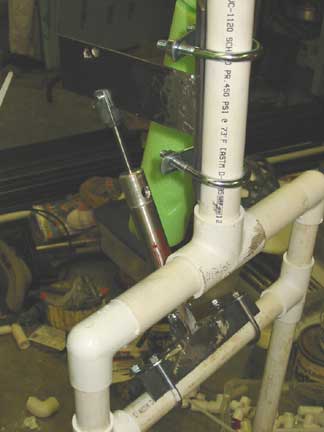
|
| Note: When working with wire mesh,
be sure to wear gloves!
I attached a 34" piece of steel rod to the front of the
upper bracket to make a waist and help define the upper body shape,
but after I was done, I think the landscape cloth alone can serve
to handle this... So its your option, rod or no rod! If no rod,
be sure to zip tie the landscape cloth to the shoulders and to
the front of the upper bracket.
Cut a 2" hole in the center of the piece of landscape cloth,
and fold it over the body (see the photo). use zip ties to attach
the landscape cloth together at the sides and bottom. Bend and
adjust the wire until it resembles a body shape. |
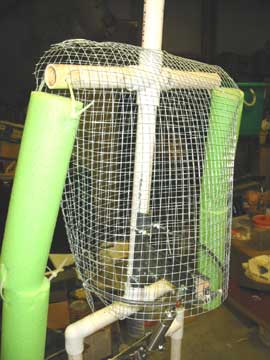 |
| Connect the air cylinder, solenoid
and timer as shown. There are dozens of styles of solenoids, timers,
and triggers - each combination affecting the details of connections.
So without supplying specific parts which may be expensive or
hard to obtain, its nearly impossible to describe details.
I buy pneumatic parts from eBay, McMaster Carr, C & H, Surplus
Center, junkyards, and my local hydraulic supply. When I start
a project, I see what I have, and to some extent, build around
the parts I've got!
If you're not sure about air fittings, look in your yellow pages
and find a local hydraulic supply. I've got a great relationship
with a small supply shop. They are happy to answer my dumb questions
and help me find the right combination of parts to hook up most
anything I've brought in. I'm sure there's a supply near you that
will be happy to help you sort out the details.
What little I've learned about pneumatics has been by trial and
error, and just trying to make it work. You can do it!
Remember SAFETY when working with air...
ALWAYS start testing with very, very low pressure - then work
up to normal operating pressure.
For a first attempt, start with 10 PSI, then work up in 10 PSI
increments. Starting with low pressure lets you find and fix the
air leaks and loose parts BEFORE slamming 60-100 PSI to the mechanics,
potentially causing the mechanism to fly apart and harm to yourself
or others.
|
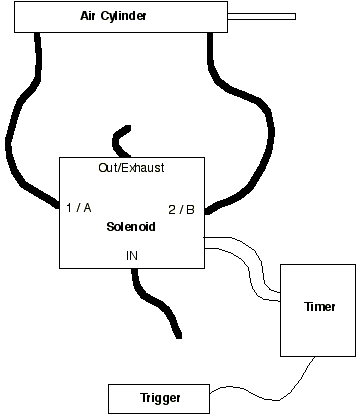 |
| Pad the legs to give them some thickness
and add realism. I had some packing bubble sheets lying around
that I duct taped to the PVC leg pieces. Be sure to leave lots
of room around the knees so the padding doesn't get caught in
the knee joint.
You may need to pad the buttocks area, too.
Attach the pants using zip ties looped through the belt loops
and through the landscape cloth.
NOTE: do not attach the pants directly in the front. You'll need
access to the inside to work on the moving parts. Its simple enough
to open the front of the pants to get in. (no jokes, please!)
Its hard to see, but the solenoid and fittings are held in the
body with zip ties.
The photo shows my test air connections. The finished body will
use 3/8" black nylon tubing to supply air to the solenoid.
|
 |
| Fit the reducing coupling into the
neck, and fit the 8" piece of 1/2 PVC to make the neck joint.
Attach the Styrofoam wig head to the 1/2" pipe. Cover the
head with whatever cloth you might have lying around (I had an
old towel). I used a belt to wrap around the neck to hold the
towel on. Attach hands (with zip ties, of course!).
I screwed the heels of the shoes into the back of the 1/2"
fittings on the foot. Then using zip ties, I tied the bottom of
the pants leg to the tops of the shoes to keep the PVC hidden.
The finished body is quite realistic in its movement. The body
here has been flailing for as long as an hour continuously without
a problem.
I need to 'sprinkle' watered down paint to add some 'funkiness'
to the clothes - after all, its been hanging out a long, long
time!
Yet another prop to worry the UPS guy with... hmmm .... wonder
if I can find a UPS uniform? ;-) |
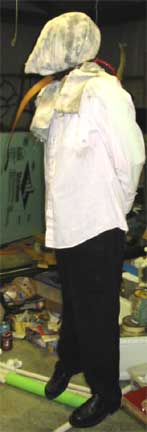 |
Index
NOTE:
Before using any information here,
please read our Disclaimer.

Copyright
© 1995-2008 Myth Adventures, Inc.
All Rights Reserved
|

